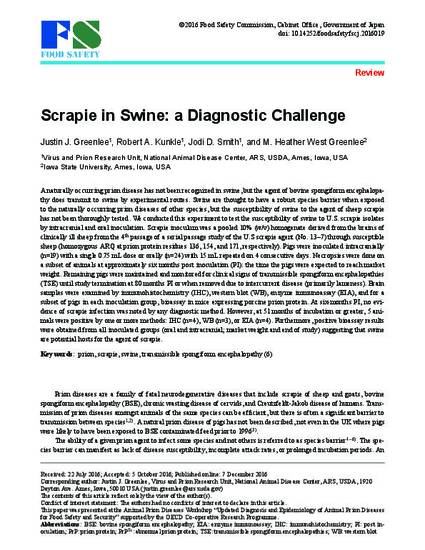
A naturally occurring prion disease has not been recognized in swine, but the agent of bovine spongiform encephalopathy does transmit to swine by experimental routes. Swine are thought to have a robust species barrier when exposed to the naturally occurring prion diseases of other species, but the susceptibility of swine to the agent of sheep scrapie has not been thoroughly tested. We conducted this experiment to test the susceptibility of swine to U.S. scrapie isolates by intracranial and oral inoculation. Scrapie inoculum was a pooled 10% (w/v) homogenate derived from the brains of clinically ill sheep from the 4th passage of a serial passage study of the U.S scrapie agent (No. 13–7) through susceptible sheep (homozygous ARQ at prion protein residues 136, 154, and 171, respectively). Pigs were inoculated intracranially (n=19) with a single 0.75 mL dose or orally (n=24) with 15 mL repeated on 4 consecutive days. Necropsies were done on a subset of animals at approximately six months post inoculation (PI): the time the pigs were expected to reach market weight. Remaining pigs were maintained and monitored for clinical signs of transmissible spongiform encephalopathies (TSE) until study termination at 80 months PI or when removed due to intercurrent disease (primarily lameness). Brain samples were examined by immunohistochemistry (IHC), western blot (WB), enzyme immunoassay (EIA), and for a subset of pigs in each inoculation group, bioassay in mice expressing porcine prion protein. At six-months PI, no evidence of scrapie infection was noted by any diagnostic method. However, at 51 months of incubation or greater, 5 animals were positive by one or more methods: IHC (n=4), WB (n=3), or EIA (n=4). Furthermore, positive bioassay results were obtained from all inoculated groups (oral and intracranial; market weight and end of study) suggesting that swine are potential hosts for the agent of scrapie.
Available at: http://works.bepress.com/jodi-smith/21/

This article is published as Greenlee, Justin J., Robert A. Kunkle, Jodi D. Smith, and M. Heather West Greenlee. "Scrapie in swine: a diagnostic challenge." Food Safety 4, no. 4 (2016): 110-114. doi:10.14252/foodsafetyfscj.2016019. Posted with permission.